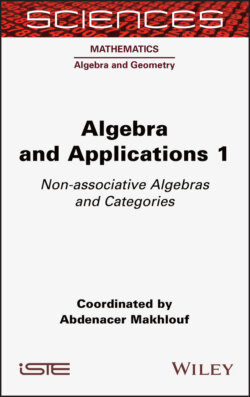Читать книгу Algebra and Applications 1 - Abdenacer Makhlouf - Страница 36
2.5. Triality
ОглавлениеThe importance of symmetric composition algebras lies in their connections with the phenomenon of triality in dimension 8, related to the fact that the Dynkin diagram D4 is the most symmetric one. The details of much of what follows can be found in (Knus et al. (1998), Chapter VIII).
Let (, ∗, n) be an eight-dimensional symmetric composition algebra over a field , that is, is either a para-Hurwitz algebra or an Okubo algebra. Write Lx(y) = x ∗ y = Ry(x) as usual. Then, due to theorem 2.3, Lx Rx = RxLx = n(x)id for any so that, inside , we have
Therefore, the map
extends to an isomorphism of associative algebras with involution:
where (, n) is the Clifford algebra on the quadratic space (, n), τ is its canonical involution (τ (x) = x for any ) and σn⊥n is the orthogonal involution on induced by the quadratic form where the two copies of S are orthogonal and the restriction on each copy coincides with the norm. The multiplication in the Clifford algebra will be denoted by juxtaposition.
Consider the spin group:
For any u ∈ Spin(, n),
for some such that
for any x, , where χu(x) = uxu−1 gives the natural representation of Spin(, n), while give the two half-spin representations, and the formula above links the three of them.
The last condition is equivalent to:
for any x, y, , where
and this has cyclic symmetry:
THEOREM 2.7.– Let (, ∗, n) be an eight-dimensional symmetric composition algebra. Then:
Spin .
Moreover, the set of related triples (the set on the right hand side) has cyclic symmetry.
The cyclic symmetry on the right-hand side induces an outer automorphism of order 3 (trialitarian automorphism) of Spin(, n). Its fixed subgroup is the group of automorphisms of the symmetric composition algebra (, ∗, n), which is a simple algebraic group of type G2 in the para-Hurwitz case, and of type A2 in the Okubo case if char .
The group(-scheme) of automorphisms of an Okubo algebra over a field of characteristic 3 is not smooth (Chernousov et al. 2013).
At the Lie algebra level, assume , and consider the associated orthogonal Lie algebra
The triality Lie algebra of (, ∗, n) is defined as the following Lie subalgebra of (with componentwise bracket):
Note that the condition d0(x ∗ y) = d1(x) ∗ y + x ∗ d2(y) for any x, is equivalent to the condition
for any x, y, . But n(x ∗ y, z) = n(y ∗ z, x) = n(z ∗ x, y). Therefore, the linear map:
is an automorphism of the Lie algebra .
THEOREM 2.8.– Let (, ∗, n) be an eight-dimensional symmetric composition algebra over a field of characteristic ≠ 2. Then:
– Principle of local triality: the projection map:
is an isomorphism of Lie algebras.
– For any x, , the triple
belongs to , and is spanned by these elements. Moreover, for any a, b, x, :
PROOF.– Let us first check that tx, y ∈ :
and hence
Also and (adjoint relative to the norm n), but RxLx = n(x)id, so RxLy + RyLx = n(x, y)id and hence , so that , and too. Therefore, .
Since the Lie algebra is spanned by the σx, y ’s, it is clear that the projection π0 is surjective (and hence so are π1 and π2). It is not difficult to check that ker π0 = 0, and therefore, π0 is an isomorphism.
Finally, the formula [ta, b, tx, y] = tσa, b(x), y + tx, σa, b(y) follows from the “same” formula for the σ’s and the fact that π0 is an isomorphism. □
Given two symmetric composition algebras (, ∗, n) and , consider the vector space:
where is just a copy of (i = 0, 1, 2) and we write , instead of and for short. Define now an anticommutative bracket on by means of:
– the Lie bracket in , which thus becomes a Lie subalgebra of ;
– [(d0, d1, d2), ιi(x ⊗ x′)] = ιi(di(x) ⊗ x′);
–
– [ιi(x ⊗ x′), ιi+1(y ⊗ y′)] = ιi+2((x ∗ y) ⊗ (x′ ★ y′)) (indices modulo 3);
–
THEOREM 2.9 (Elduque (2004)).– Assume char . With the bracket above, is a Lie algebra and, if and denote symmetric composition algebras of dimension r and s, then the Lie algebra is a (semi) simple Lie algebra whose type is given by Freudenthal’s magic square:
Different versions of this result using Hurwitz algebras instead of symmetric composition algebras have appeared over the years (see Elduque (2004) and the references therein). The advantage of using symmetric composition algebras is that new constructions of the exceptional simple Lie algebras are obtained, and these constructions highlight interesting symmetries due to the different triality automorphisms.
A few changes are needed for characteristic 3. Also, quite interestingly, over fields of characteristic 3 there are non-trivial symmetric composition superalgebras, and these can be plugged into the previous construction to obtain an extended Freudenthal’s magic square that includes some new simple finite dimensional Lie superalgebras (see Cunha and Elduque (2007)).
